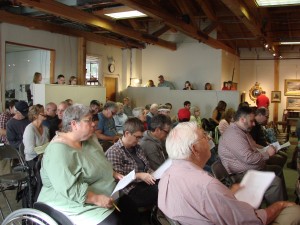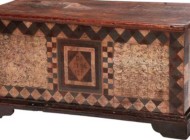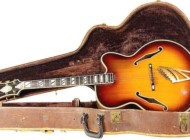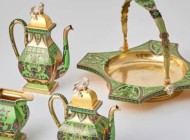
The top-selling lot of the day was an oil on canvas by Benjamin Champney depicting “The Prow,” an unusual rock formation near his home in North Conway, N.H. At least three phone bidders competed for the painting that achieved $14,400. It, and other White Mountain paintings, descended in a family that had bought directly from the artists.
Review and Onsite Photos by Rick Russack, Catalog Photos Courtesy The Cobbs Auctioneers
PETERBOROUGH, N.H. — It is not often that we talk about Charles Dickens as one of the lead items in a good sale of fine art and American antiques. Aside from three paintings by Benjamin Champney, which led the sale, a fine first edition set of David Copperfield in original wraps was a highlight of Charlie Cobb’s September 24 sale.
There were other good paintings, including more by White Mountains artists, American furniture, silver, jewelry, Oriental rugs, firearms and ethnographic items. Cobb had a full house, with several phone lines ready, internet bidding on two platforms and numerous absentee bids. There were a number of pleasant surprises, and a few items that may have slipped under the radar, resulting in good buys for some alert dealers.
Most of the White Mountains paintings descended in the family that had purchased the paintings directly from the artists, including four by Benjamin Champney (1817–1907), two by Edward Hill (1843–1923) and one by Frank Shapleigh (1842–1906). Champney lived in North Conway, N.H., and produced many paintings of the landscapes around his home. Leading the sale was his painting of “The Prow,” a very distinctive nearby rock formation. It’s part of the massive Cathedral Ledge, and today draws rock climbers from near and far. One of the websites that describes the climb includes the caution “Attempting to climb this route can get you injured or killed.” Champney’s painting conveys the ruggedness of the site. Multiple phone bidders competed and the painting sold within estimates at $14,400. Cobb had two other local paintings by Champney, one of “Moat Mountain South” and the other “Moat Mountain North.” He sold them together, and the pair went to a phone bidder for $9,000. Later in the sale, a still life of flowers in a vase, not as desirable to Champney collectors as his landscapes, from the same collection, brought $360, also from a phone bidder.
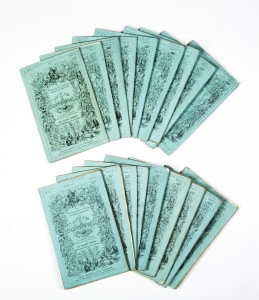
Cory King, a Charles Dickens collector from Rhode Island, came specifically for this first edition set of David Copperfield. As with many of Dickens’s works, it was originally published in serial form and this set was complete and in very fine condition. King compared each of the 20 parts to a detailed bibliography of Dickens’s periodical works, found it to be complete and paid $6,600 for the set.
Edward Hill’s painting of Mount Ascutney in Vermont realized $1,560. Shapleigh’s oil on linen painting of two young boys preparing for a swim in a rugged mountain pond, surrounded by trees and rocks, seemed reasonable at $780. From the same collection came three paintings by George Albert Frost (1817–1907). A striking oil depicting two dog sleds traveling in Siberia ended up at $1,920. His winter scene of a snow covered log encampment, with multiple dog sleds, resting sled dogs and a man carrying firewood under a stormy sky, realized $1,320.
About the Charles Dickens item that did quite well, Cory King, a 28-year-old collector from Rhode Island, who has been collecting Dickens for about three years, came specifically for the first edition set of David Copperfield in original wraps. The full title of the book is The Personal History, Adventures, Experience and Observation of David Copperfield the Younger of Blunderstone Rookery (Which He Never Meant to Publish on Any Account).
The first appearance of what Dickens later said was his favorite work was published as a serial in 20 parts, beginning in 1849, and first published in book form in 1850. Each part, in blue wrappers, was in very fine condition and the set was housed in an early leather and cloth slipcase. King had with him a copy of the standard bibliography of Dickens’s periodical works, written by Hatton and Cleaver, published in 1933. It describes exactly what should be included in each part, including number of illustrations and number of advertising pages.
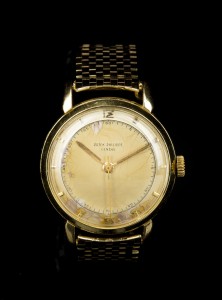
The sale included a number of watches. The highest price of the group was achieved by this Patek Philippe Calatrava model, with a marked 14K gold band, sold by New York jeweler David Friedman and Sons, which reached $5,700.
King carefully compared each part to the description in the bibliography and told Antiques and The Arts Weekly, “The set is complete with all ads, plates and the bibliographic points that a collector would look for. It is in very fine condition and has been in that slipcase for a long time. Each part has the inked signature of the prior, probably original, owner of the set. That increases the value of the set as it indicates that the set had been owned by one person, probably acquired as they were printed, and not assembled at some later time. Dickens died in 1870 and his works have been collected since just about that date.” After he purchased the set for $6,600, he said that he was very pleased with the purchase and thought the set might have been priced between $12,000 and $18,000 by a specialist book dealer.
Cobb had some good furniture and one piece in particular may have been a very good buy. Cataloged as a circa 1819 desk from the New Hampshire state house and one of only three survivors of the form, it earned $4,200 from a dealer in the room. It was made of bird’s-eye maple and mahogany by Porter Blanchard, Concord, N.H. Invoices survived from Blanchard, indicating that he made furniture for the state house and his furniture was in use there until 1866. The desk descended in the family of William Eaton Chandler, who had served in the state’s house of representatives from 1862–64, before being appointed by President Lincoln as judge advocate general of the Navy department in 1865. He was later appointed secretary of the Navy by President Chester Allen Arthur.
In 1874, after his first wife’s death, he resumed an earlier romance with, and married, Lucy Hale, who had been secretly engaged to John Wilkes Booth. That’s not a bad provenance for a piece of furniture. The desk had replaced brasses and the feet were trimmed about 2 inches. It was estimated at $7/10,000 and sold on a single bid to Justin Cobb, who specializes in nautical items and marine paintings. Cobb, who is not related to auctioneer Charlie Cobb, said that he had not planned on buying the desk, but, “It’s an important piece of New Hampshire history and I’m sure I can make some money on it.”
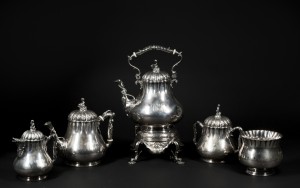
Made by Boston silversmiths Lincoln and Foss, this coin silver tea set weighed 146 ounces and was monogrammed for William Eaton Chandler, who also owned the state house desk. It sold to a dealer in the room for $5,100.
Some other furniture did well and some pieces were bargains. Selling for more than three times over estimate was a Federal period, glazed door secretary, probably from the mid-Atlantic region, circa 1800–10. The top section had an inlaid satinwood crest, three line-inlaid drawers and a fold-down writing surface. It achieved $5,700, against an estimate of $1,800. A southern Hepplewhite inlaid chest of drawers, with a shaped apron and a central inlaid fan, doubled its estimate, attaining $2,760. In the “bargains” department was a Nineteenth Century Sheraton mahogany work table, with nicely turned legs, two drawers and a bag, which brought $270. Also exceeding the estimates was a 30-hour wooden works tall case clock by Abraham and Calvin Edwards, Ashby, Mass. The brothers were only in business from 1792 to 1796. According to John Delaney, the brothers are believed to have made more than 500 clocks. This one had three brass finials over an arched bonnet and it achieved $1,920.
Several lots of silver did well, with a five-piece coin silver tea set made by Lincoln and Foss, Boston silversmiths, active from 1847–58. The set, weighing 146 troy ounces, was monogrammed for W.E. Chandler, Concord, N.H., who is discussed above, and realized $5,100. An Indian four-piece tea set, marked “95 silver,” with ornate raised decoration, on a 15-inch oval tray, earned $1,560 and 16 pieces of Asian silver tableware, made from silver coins, with 62.5 troy ounces of silver, fetched $900.
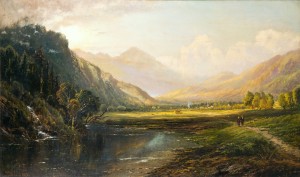
The dramatic oil on canvas view of “Nebraska Notch” in Vermont was signed by Edmund Darch Lewis (1827–1908), dated 1876 and identified by the artist. It sold under estimate for $4,800.
There were several other interesting items. An undecorated Grueby pottery vase, about 8 inches tall with a very unusual “dripped” apple-green glaze, finished at $420. Performing the best of several lots of ethnographic material was a rare wooden Haida or Tlinglit shaman’s half-face masquette, with an encrusted old surface, over almost ossified wood. It was about 5 inches long and earned $3,000. A group of 14 prehistoric Inuit harpoon fragments, most with perforated tapering tips, brought $480. A scrimshawed animal rib, decorated with a sea serpent and the “Brig Titan” 8¾ inches long, made a final price of $420.
A phone bidder took three gold coins, including a $20 Liberty head double eagle coin, dated 1896, with excellent definition, for $1,320. A set of eight Tiffany champagne flutes, in their original box, each with their original Tiffany label, which had been given to the consignor as a wedding present but never used, reached $330.
Cobbs is a family-run business, which can trace its roots back to 1967 when Charlie and his wife, Dudley, went into the antiques business in a 1760 house in New Jersey. They moved a few times, always into historic buildings, which they preserved, until in 1998 they purchased the historic Noone Falls mill in Peterborough, where they now conduct their auctions.
Speaking a few days after the sale, Charlie Cobb said, “I was pleased to see the resurgence of interest in good American furniture. There were several bidders on most of the pieces, and we haven’t always seen that. Silver and jewelry did well, with a number of things bringing more than we thought they might. American paintings were strong but we had a good French painting that did not do as well as we thought it should,” he said, the latter referring to the Jules Alexis Muenier painting that sold well under estimate. “Some of the Japanese items went to buyers in Japan bidding on the internet. All in all, it was an encouraging sale and we delivered for our consignors.”
All prices reported include the buyer’s premium.
For additional information, www.thecobbs.com or 603-924-6361.
[slideshow_deploy id=’1000275634′]
